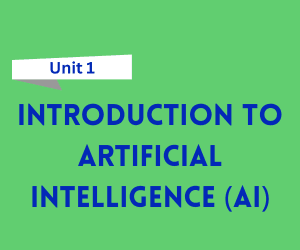
Free Download Introduction to Artificial Intelligence (AI) Notes in pdf – Bca 6th Semester. High quality, well-structured and Standard Notes that are easy to remember.
Click on the Download Button 👇
Introduction to Artificial Intelligence (AI)
Artificial Intelligence (AI) is a branch of computer science focused on building systems capable of performing tasks that typically require human intelligence. These tasks include problem-solving, decision-making, learning, and natural language processing. AI leverages data, algorithms, and computational power to simulate intelligent behavior.
Key Points about AI
- Definition: AI refers to the simulation of human intelligence in machines programmed to think and act like humans.
- Core Areas:
- Machine Learning (ML)
- Natural Language Processing (NLP)
- Computer Vision
- Robotics
- Expert Systems
- Applications: Used in healthcare, finance, transportation, customer service, and more.
- Types of AI:
- Narrow AI: Focused on specific tasks (e.g., voice assistants).
- General AI: Hypothetical AI with human-level intelligence.
- Super AI: Theoretical AI surpassing human intelligence.
- Ethical Concerns: Includes bias, job displacement, and data privacy.
Features of Artificial Intelligence
- Automation: AI can perform repetitive tasks without human intervention.
- Learning: Utilizes data to improve performance over time (machine learning).
- Adaptability: Can adjust to new data or changing environments.
- Natural Language Understanding: Enables communication through spoken or written language.
- Problem-Solving: Offers efficient solutions to complex problems.
- Predictive Analysis: Anticipates outcomes based on historical data.
- Autonomy: Operates independently in certain scenarios (e.g., self-driving cars).
FAQs on Artificial Intelligence
Q1: What is Artificial Intelligence used for?
AI is used for automating tasks, improving decision-making, analyzing data, powering virtual assistants, driving autonomous vehicles, and enhancing customer experience, among other applications.
Q2: How does AI work?
AI works by processing large datasets using algorithms and learning from patterns in the data. Techniques like machine learning and deep learning are often used to train AI systems.
Q3: What is the difference between AI and Machine Learning?
AI is the broader concept of machines exhibiting intelligence. Machine Learning is a subset of AI focused on systems that learn and improve from experience.
Q4: Is AI safe?
AI is generally safe when developed and deployed responsibly. Ethical concerns include data privacy, decision-making biases, and misuse of technology.
Q5: Can AI replace human jobs?
AI can automate repetitive tasks and may replace certain jobs. However, it also creates new opportunities in technology, data analysis, and other fields.
Q6: What are the limitations of AI?
AI systems can struggle with:
- Lack of creativity
- Bias in training data
- High computational resource requirements
- Inability to understand emotions fully